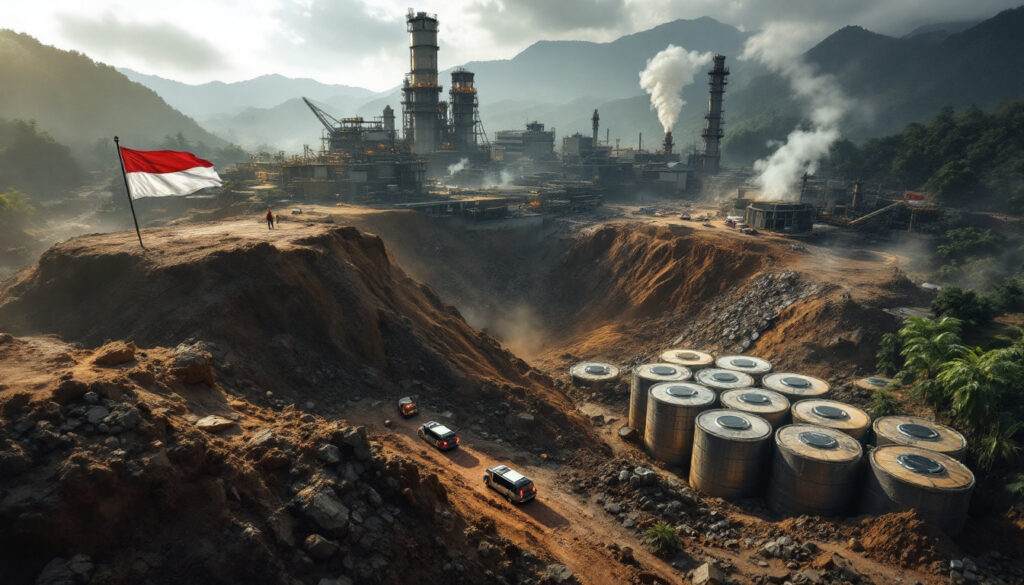The Deadly Landslide at Indonesia's Major Nickel Plant: Impact and Recovery
On March 14, 2025, tragedy struck at one of Indonesia's key nickel processing facilities when a devastating landslide hit the PT QMB New Energy Materials plant in the Indonesia Morowali Industrial Park (IMIP). The disaster claimed the lives of two workers, with another still missing, and forced an almost complete shutdown of operations at this strategically important facility.
The Deadly Landslide Incident: What Occurred?
The March 2025 landslide affected a tailings storage area at the QMB facility, which is situated within Indonesia's largest nickel processing hub. According to reports from Bloomberg News, the collapse happened during heavy rainfall, catching workers by surprise despite the region's known susceptibility to landslides during Indonesia's wet season.
"The search for the third worker had officially been called off, though the company had not stopped its own efforts to find him," stated an IMIP spokesperson in communications with Mining.com on May 8, 2025. The missing worker is presumed dead, bringing the total fatalities to three.
The immediate impact was severe—the plant was forced to suspend virtually all production operations following the disaster. Engineers determined that the tailings dam structure had been compromised, necessitating comprehensive safety evaluations before any resumption could be considered.
Industry analysts noted this incident followed a troubling pattern of safety incidents in Indonesia's rapidly expanding nickel sector. According to the Indonesian Mining Association, this was the fifth serious incident at nickel processing facilities in the country since 2023, raising urgent questions about safety standards in the industry.
How Has the Plant Resumed Operations?
After approximately two months offline, PT QMB New Energy Materials has gradually restarted production as of early May 2025. Current reports indicate the facility is operating at 70-80% of its pre-incident capacity, with a carefully managed ramp-up process underway.
"The company has implemented extensive safety improvements following a comprehensive review of their tailings management system," reported Mining.com, though specific technical modifications have not been publicly disclosed by PT QMB or regulatory authorities.
The restart required approval from multiple Indonesian regulatory bodies, including the Ministry of Energy and Mineral Resources and the Ministry of Environment and Forestry. This process likely involved:
- Structural reinforcement of remaining tailings storage facilities
- Implementation of enhanced monitoring systems
- Revision of emergency response protocols
- Retraining of personnel on safety procedures
Dimas Hartono, an Indonesian mining safety consultant, told local media: "The restart approval suggests significant changes to their waste management practices, though the industry would benefit from greater transparency about specific measures implemented."
No timeline has been provided for when the facility might return to 100% operational capacity, suggesting a cautious approach by both regulators and plant management.
Why Is This Nickel Plant Significant to Global Markets?
The QMB facility represents a critical node in the global battery supply chain, with particular importance for electric vehicle manufacturing. Its strategic significance stems from several key factors:
Production Capacity and Material
The plant specializes in producing mixed hydroxide precipitate (MHP), a critical intermediate nickel product that also contains valuable cobalt. MHP serves as a primary feedstock for high-nickel battery cathodes used in electric vehicles. According to industry estimates, the facility has an annual production capacity of approximately 50,000 tonnes of nickel and 5,000 tonnes of cobalt in MHP form.
Ownership Structure
PT QMB New Energy Materials operates through a consortium of major players in the battery metals investment sector:
- China's GEM Co. (36% ownership stake) – A leading battery recycling and materials company
- Tsingshan Holding Group Co. (21%) – The world's largest stainless steel producer
- Guangdong Brunp Recycling Technology Co. Ltd. (25%) – A subsidiary of CATL, the world's largest EV battery manufacturer
- Additional minor shareholders (18%)
This ownership structure links the facility directly to major battery supply chains servicing global EV manufacturers.
Strategic Position
The facility is located in Indonesia's Morowali Industrial Park, which has become the epicenter of Indonesia's strategy to move up the nickel value chain. Rather than exporting raw nickel ore, Indonesia has aggressively developed downstream processing capability, with IMIP hosting multiple integrated facilities for producing stainless steel and battery materials.
"When a major MHP producer like QMB goes offline, even temporarily, it creates ripple effects through the entire battery supply chain," explains Jessie Liu, metals analyst at Bloomberg Intelligence. "The restart alleviates immediate concerns, but highlights ongoing vulnerabilities."
What Are the Broader Implications for Indonesia's Nickel Industry?
Indonesia's Dominance in Global Nickel Production
Indonesia has transformed the global nickel landscape over the past decade. From being primarily an exporter of unprocessed ore, the country has implemented policies that banned raw exports and incentivized massive investments in processing facilities. This strategic pivot has been remarkably successful in economic terms:
- Indonesia now accounts for more than 50% of global nickel output
- The country has attracted over $30 billion in investments for nickel processing since 2014
- Production has shifted dramatically from raw ore to higher-value materials including:
- Nickel pig iron (NPI)
- Ferronickel
- Nickel matte
- Mixed hydroxide precipitate (MHP)
This trajectory has positioned Indonesia as the indisputable center of gravity for global nickel production, with particular leverage over battery-grade materials essential for the energy transition.
Safety and Environmental Concerns
The QMB landslide has intensified scrutiny of Indonesia's nickel sector, particularly regarding:
HPAL Technology Risks
The High-Pressure Acid Leaching (HPAL) method employed at QMB and several other Indonesian facilities enables the extraction of nickel from laterite ores that were previously considered economically unviable. However, this process generates enormous volumes of waste material—approximately 100 tonnes of tailings for every tonne of nickel produced, according to industry estimates.
Environmental Management Challenges
HPAL operations produce acidic, metal-laden waste slurry that requires careful neutralization and long-term storage. The QMB incident highlighted the hazards associated with tailings management in a region with:
- High annual rainfall (over 2,500mm)
- Frequent seismic activity
- Challenging topography
- Dense population in certain areas
Industry Growth vs. Safety Infrastructure
Environmental groups have criticized the pace of development, suggesting safety and environmental infrastructure has not kept pace with production capacity. A 2024 report by the Indonesian Forum for Environment (WALHI) documented 12 significant environmental incidents at nickel processing facilities between 2019-2024, affecting local communities and ecosystems.
How Does This Affect Global Nickel Supply and Markets?
Current Market Dynamics
The nickel market presents a complex picture that varies significantly by product type:
| Nickel Product Type | Market Status | Price Trend (2024-2025) | Key Applications |
|---|---|---|---|
| Class 1 Nickel | Surplus | Declining | Aerospace, Specialty Alloys |
| Ferronickel/NPI | Balanced | Stable | Stainless Steel |
| MHP/Nickel Sulfate | Tight Supply | Rising | EV Batteries |
While overall nickel markets have experienced persistent surpluses driving London Metal Exchange (LME) prices lower throughout 2024, the specific MHP product produced at QMB has faced supply constraints. This divergence highlights the growing segmentation of nickel markets between traditional and battery applications.
The two-month shutdown at QMB temporarily removed approximately 8,000-10,000 tonnes of nickel in MHP form from global supply, according to analyst estimates. This contributed to localized price premiums for battery-grade materials despite broader nickel market weakness.
Supply Chain Implications
The QMB incident and subsequent production disruption has catalyzed several important realizations across the battery supply chain:
-
Geographic Concentration Risk
The concentration of MHP production in Indonesia (nearly 65% of global output) creates systemic vulnerability, particularly as battery manufacturers have limited inventory buffers for these materials. -
Alternative Sourcing Interest
Battery manufacturers and automakers have accelerated efforts to develop alternative sources of battery-grade nickel, including:- Increased recycling capacity
- Projects in Australia, Canada and Brazil
- Research into nickel-light or nickel-free battery chemistries
-
Safety-Growth Balance
The incident has prompted stakeholders to question the sustainability of Indonesia's rapid expansion model, with investors increasingly factoring safety and environmental performance into risk assessments.
"The QMB restart brings welcome relief to tight MHP markets, but the incident exposes fundamental vulnerabilities in battery supply chains that will take years to address," noted Chloe Wang, commodities analyst at Wood Mackenzie.
What Production Methods Are Used at the Facility?
High-Pressure Acid Leaching (HPAL) Technology
The QMB facility employs High-Pressure Acid Leaching technology, a complex hydrometallurgical process specifically designed to extract nickel and cobalt from lateritic ores that contain relatively low concentrations of these metals (typically 1-1.5% nickel).
The HPAL process involves several critical stages:
-
Ore Preparation
- Crushing and grinding of lateritic ore
- Slurry formation by mixing with water
-
Acid Leaching
- Introducing sulfuric acid to the slurry
- Processing under high pressure (40-45 bar) and temperature (245-270°C)
- Using specialized titanium-lined autoclaves resistant to corrosion
-
Solid-Liquid Separation
- Removing solid waste (primarily iron oxides)
- Counter-current decantation and filtration
-
Metal Recovery
- Precipitation of nickel and cobalt as mixed hydroxides
- Thickening and filtering to produce MHP product (approximately 35-40% nickel content)
This technology enables Indonesia to capitalize on its extensive laterite resources that were previously considered marginal deposits. However, HPAL operations face significant technical challenges, including:
- High capital expenditure ($30,000-50,000 per annual tonne of nickel capacity)
- Substantial energy requirements (primarily from coal in Indonesia)
- Complex operational control needs
- Significant maintenance demands due to corrosive conditions
Environmental Considerations
The environmental footprint of HPAL operations centers primarily around tailings management:
Tailings Volume and Characteristics
HPAL generates approximately 100 tonnes of residue for each tonne of nickel produced. For a facility of QMB's scale, this translates to millions of tonnes of waste material annually with characteristics including:
- High iron content
- Residual acidity (though neutralized before disposal)
- Trace heavy metals
- Fine particle size prone to mobilization during rainfall
Disposal Methods
Indonesian HPAL operations typically employ one of two tailings management approaches:
- Terrestrial storage in engineered tailings dams
- Deep sea tailings placement (DSTP) in some coastal facilities
The QMB facility utilizes terrestrial storage, which requires careful engineering to manage Indonesia's high rainfall and potential seismic activity. The New Zealand tunnel collapse earlier this year demonstrated how catastrophic structural failures can be in similar challenging environmental conditions. The March landslide highlights the inherent risks of this approach, particularly in challenging topographic and climatic conditions.
What Safety Measures Are Being Implemented in Indonesia's Nickel Sector?
Industry-Wide Safety Challenges
Indonesia's nickel industry has experienced numerous safety incidents during its rapid expansion phase, including:
- Fatal accidents affecting workers
- Tailings dam integrity issues
- Structural failures at processing facilities
- Community impacts from emissions and effluents
These challenges stem from several underlying factors:
-
Accelerated Development Timeline
Indonesia's determination to rapidly ascend the value chain has compressed development schedules that might have unfolded over decades in other jurisdictions. -
Technical Complexity
HPAL and other advanced processing technologies require sophisticated engineering and operational expertise that has been developed in real-time. -
Scale of Operations
The sheer scale of Indonesia's nickel industry expansion—adding hundreds of thousands of tonnes of processing capacity in less than a decade—creates inherent management challenges. -
Workforce Development
Rapidly training a workforce skilled in advanced metallurgical processes presents ongoing challenges for safety culture development.
Regulatory Response
Following the QMB incident and previous safety failures, Indonesia's regulatory framework is evolving in several key directions:
Enhanced Oversight
The Ministry of Energy and Mineral Resources has indicated plans for more rigorous inspection regimes, particularly focused on:
- Tailings storage facilities
- Pressure vessels and autoclaves
- Process safety management systems
- Emergency response capabilities
International Standards Adoption
Indonesian authorities have signaled intentions to align more closely with international standards, including:
- Global Industry Standard on Tailings Management
- International Council on Mining and Metals (ICMM) safety principles
- ISO 45001 occupational health and safety standards
Balancing Growth and Safety
The fundamental challenge for Indonesian regulators remains balancing ambitious industrial development goals with safety and environmental protection. This tension is increasingly visible in:
- Extended permitting timelines for new projects
- More detailed environmental impact assessment requirements
- Greater community consultation mandates
"Indonesia recognizes that sustainable development of our nickel resources requires world-class safety standards," stated Indonesia's Minister of Energy and Mineral Resources at a recent industry conference. "The incidents we've seen are unacceptable and require a coordinated response from government and industry."
Recent industry evolution trends indicate that safety and sustainability are becoming increasingly important factors in investment decisions across the mining sector. Companies are recognizing that mine reclamation innovation and robust environmental practices are essential for maintaining their social license to operate.
FAQ About Indonesia's Nickel Industry
Why is Indonesia's nickel production so important globally?
Indonesia possesses approximately 21% of global nickel reserves but accounts for over 50% of production due to aggressive development policies. The country's strategic importance stems from:
- Volume dominance: Indonesia produced approximately 1.6 million tonnes of nickel in 2024
- Resource quality: Extensive laterite deposits suitable for both stainless steel and battery applications
- Integrated processing: Rapid development of the full value chain from mining to battery materials
- Strategic positioning: Close proximity to major Asian manufacturing hubs
The country's output has become essential for both traditional stainless steel manufacturing (consuming about 70% of global nickel) and the rapidly growing electric vehicle battery sector (approximately 15% of demand but increasing rapidly).
What is mixed hydroxide precipitate (MHP) and why does it matter?
MHP is an intermediate nickel product that also contains cobalt, making it particularly valuable for battery manufacturing. It typically contains:
- 35-40% nickel content
- 2-3% cobalt content
- Minimal impurities compared to traditional nickel products
Despite overall nickel surpluses, MHP specifically has faced supply constraints due to:
- Limited production facilities globally (primarily in Indonesia, with some in Papua New Guinea and Cuba)
- Growing demand from battery manufacturers
- Technical challenges in production
- Long development timelines for new capacity
This makes production disruptions at facilities like QMB particularly significant for downstream battery and EV manufacturers, who often lack sufficient inventory buffers.
What safety challenges does Indonesia's nickel industry face?
The industry has experienced numerous accidents during its rapid expansion, reflecting several underlying challenges:
- Geological conditions: High rainfall (2,500-3,000mm annually) creates significant water management challenges
- Technical complexity: Advanced processing methods require sophisticated control systems and highly trained personnel
- Pace of development: Compressed timelines for project development leave less margin for error
- Regulatory evolution: Safety standards and enforcement mechanisms developing alongside industry growth
- Infrastructure limitations: Power, transportation, and emergency response capabilities stretched by rapid expansion
These factors have contributed to a concerning safety record, with multiple fatal incidents reported across different facilities since 2020.
How does the High-Pressure Acid Leaching (HPAL) process impact the environment?
HPAL technology enables processing of lower-grade nickel ores but generates substantial environmental challenges:
Resource Intensiveness:
- Water usage: Approximately 50-100 cubic meters per tonne of nickel produced
- Energy consumption: 14-18 MWh per tonne of nickel (primarily coal-powered in Indonesia)
- Sulfuric acid: 250-500 kg per tonne of ore processed
Waste Generation:
- Tailings volume: ~100 tonnes per tonne of nickel
- Neutralization requirements: Substantial limestone consumption
- Potential for acid drainage if improperly managed
Emissions Profile:
- Significant CO2 footprint from energy usage
- Potential for sulfur dioxide emissions
- Process steam releases
The environmental footprint makes proper facility design, operation, and regulation crucial for sustainable development of this technology in Indonesia's growing nickel sector. As [industry consolidation trends](https://discoveryalert.com.au/news/mining-industry-consolidation-2025-joint-ventures
Want to Get Ahead of the Market on the Next Major Discovery?
Discover significant mineral finds before the market does with Discovery Alert's proprietary Discovery IQ model, delivering instant notifications on high-potential ASX discoveries across all major commodities. Visit our discoveries page to see how historic mineral discoveries have delivered exceptional returns, and start your 30-day free trial today.




